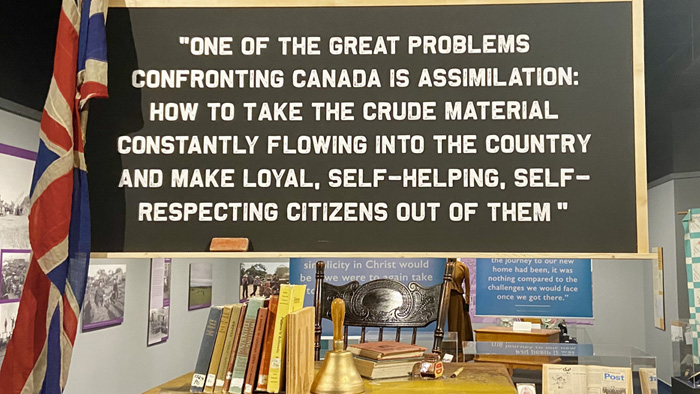Did you know that your identity, your culture is always changing? Sometimes for the worse, but often for the better. The current exhibit “Leaving Canada: the Mennonite Migration to Mexico” provides visitors to Mennonite Heritage Village (MHV) a close-up view of a pivotal moment when 8,000 Mennonites decided to leave Canada in the hopes of preserving their autonomy and culture. In the early 1900s the Dominion of Canada was pushing for all its citizens to be loyal British subjects, especially the next generation of young people who were required to attend public schools.
In this exhibit you will see the image of a notebook cover from a Mennonite student of that era. If you look closely, you will see that there were numerous Union Jack flags at the 1915 grand military parade in Winnipeg. The Canada flag had yet to be developed. You will also read this quotation on the chalkboard (see the following image from our gallery) from a writer of a magazine that was the predecessor to Maclean’s: “One of the great problems confronting Canada is assimilation: how to take the crude material constantly flowing into the country and make loyal, self-helping, self-respecting citizens out of them. (Alfred Fitzpatrick).” Mennonites were part of that ‘crude material’ that Fitzpatrick was derisively writing about.
This past week MHV hosted a Canada Day celebration. With nearly 5,000 visitors it was one of our highest attendance numbers. MHV staff and volunteers worked hard throughout the day to keep the lines and activities humming. There was also a land acknowledgement poem, a prayer for peace and an exhortation to take time to reflect on where our nation is at. We like to rejoice with those who rejoice, but also need to mourn with those who still mourn.
Canada Day was only developed in 1982, before that it was Dominion Day, which highlighted the British Empire. Many people at that time opposed the change. Ironically, many of those same people, 40 years later, would probably oppose any change to Canada Day. Some of us have trouble with change and the on-going development of culture. Sometimes we are quick to call attempts at reform ‘cancel culture’. Ultimately, what we want to see is ‘engaged culture’. People across this land who take time to really learn the good and bad of our shared history, to listen to each other and reflect on what those who are in mourning need. We celebrate, we grieve, we learn, we change – for we are human. May we also be an engaged culture.




